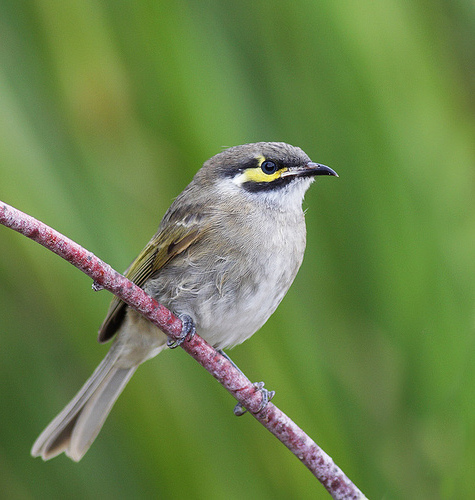Colours
Distinguishing features
It is a medium-small, greyish-brown bird that takes its common name from distinctive yellow stripes on the sides of the head. Yellow feathers form a narrow stripe above the gape, then broaden and curve below the eye to end in a small white patch of feathers on the ear-coverts. Above the yellow stripe is a black eye stripe which is broken by a small yellow to off-white patch behind the eye, and below is another distinct black stripe running the length of the yellow line. The chin and throat are a pale greyish-brown, streaked with slightly darker grey, and the upper body is a dark greyish-brown to olive-brown. Olive green outer edges on the remiges combine to form an olive panel on the folded wing. The bill is black and slightly down-curved, and the gape is cream.
The iris is a dusky blue in adult birds, and brown in juveniles. Juveniles are very similar to the adult, with slightly less streaking on the breast, an orange-brown tip on the bill and a yellower gape; male and female birds are also similar, with the male being slightly larger; and in the field there are no visible differences between the subspecies. (Wikipedia)
Size
- Up to 17.5 cm (Length of specimen)
Wingspan
- From 21.5 cm to 26.5 cm
Synonyms
Distribution

©Atlas of Living Australia: Australian distribution: Yellow-faced Honeyeater (Lichenostomus chrysops)
Distribution and habitat preferences
It is widespread across eastern and south eastern Australia, in open sclerophyll forests from coastal dunes to high-altitude subalpine areas, and often in riparian woodlands. It is usually found in open forests dominated by Spotted Gum with ironbarks and stringybarks such as Eucalyptus crebra and Eucalyptus melanophloia, with a light shrubby understory, and less often in dry open forests and woodlands dominated by Angophora, Acacia, Banksia, Casuarina or Callitris. It occurs in high-altitude, tall, open forests of Alpine Ash and woodlands dominated by Snow Gum or White Box.
It has been recorded in coastal heath when Banksias are flowering, and amongst flowering mangroves. It occupies areas infested with weeds such as Scotch Broom and Blackberries, and developed areas including orchards and parks and gardens, where it feeds on cultivated fruit and flowers. It can be found in forests regenerating after fire or logging, though it is more common in mature forests. (Wikipedia)
Diet
Comparatively short-billed for a honeyeater, it is thought to have adapted for a mixed diet. Its diet consists of nectar, pollen, fruit, seeds, honeydew and insects.
It is arboreal, foraging primarily amongst the foliage and flowers of trees, shrubs and mistletoes, less often on branches and tree trunks. (Wikipedia)



